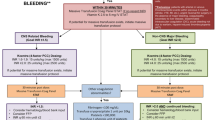Abstract
Dosing of 4-factor prothrombin complex concentrate (4FPCC) in warfarin treated patients generally utilizes international normalized ratio (INR) and patient weight. The recommended maximum dosing for all INR categories is capped at 100 kg weight. Whether this affects INR reversal is unknown. Furthermore, characteristics associated with adequate INR reversal need to be further elucidated. This was a multi-center, retrospective cohort study of 186 patients who received 4FPCC for INR reversal in the setting of warfarin-associated hemorrhage or need for emergent INR reversal. Utilizing multiple regression analysis, we evaluated INR reversal, achievement of hemostasis, and 28-day all-cause mortality. A target INR < 1.4 was achieved in 132 of 186 patients (71%). Factors significantly affecting the odds of achieving target INR were age in years (OR 1.03; 95% CI 1.01–1.06; P = 0.01), weight-based 4FPCC dose (units/kg) (OR 1.04; 95% CI 1.00–1.08; P = 0.03), and 4FPCC dosing normalized to INR (units/kg/INR) (OR 1.18; 95% CI 1.03–1.35; P = 0.02). Hemostasis was achieved in 109 of 148 bleeding patients (73.6%). Blood transfusions were associated with not achieving hemostasis (OR 0.44; 95% CI 0.21–0.93; P = 0.03). All-cause 28-day mortality was 21.5% and was associated with intracranial hemorrhage (OR 2.83; 95% CI 1.38–5.8; P = 0.01). Adequate INR reversal was associated with age, weight-based 4FPCC dose, and dosing normalized to INR (units/kg/INR). Future studies should evaluate the appropriateness of current INR targets for warfarin reversal and alternative 4FPCC dosing strategies such as utilizing a 4FPCC dosing ratio of units/kg/INR.


Similar content being viewed by others
Data availability
Data available upon reasonable request.
Code availability
Not applicable.
References
Tomaselli GF, Mahaffey KW, Cuker A et al (2017) 2017 ACC expert consensus decision pathway on management of bleeding in patients on oral anticoagulants: a report of the American college of cardiology task force on expert consensus decision pathways. J Am Coll Cardiol 70:3042–3067
Frontera JA, Lewin JJ, Rabinstein AA et al (2016) Guideline for reversal of antithrombotics in intracranial hemorrhage: executive summary. A statement for healthcare professionals from the Neurocritical Care Society and the Society of Critical Care Medicine. Crit Care Med 44:2251–2257
Sarode R, Milling TJ, Refaai MA et al (2013) Efficacy and safety of a 4-factor prothrombin complex concentrate in patients on vitamin K antagonists presenting with major bleeding: a randomized, plasma-controlled, phase IIIb study. Circulation 128(11):1234–1243
Chu C, Tokumaru S, Izumi K, Nakagawa K (2016) Obesity increases risk of anticoagulation reversal failure with prothrombin complex concentrate in those with intracranial hemorrhage. Int J Neurosci 126(1):62–66
Smetana KS, Ziemba R, May CC, Erdman MJ, Van matre ET, Jones GM (2019) Adjusted versus actual body weight dosing of 4-factor prothrombin complex concentrate in obese patients with warfarin-associated major bleeding. J Thromb Thrombolysis 47(3):369–374
Khorsand N, Veeger NJ, Muller M et al (2011) Fixed versus variable dose of prothrombin complex concentrate for counteracting vitamin K antagonist therapy. Transfus Med 21(2):116–123
Khorsand N, Veeger NJ, van Hest RM, Ypma PF, Heidt J, Meijer K (2012) An observational, prospective, two-cohort comparison of a fixed versus variable dosing strategy of prothrombin complex concentrate to counteract vitamin K antagonists in 240 bleeding emergencies. Haematologica 97(10):1501–1506
Khorsand N, Giepmans L, Meijer K, van Hest RM, Veeger NJ (2013) A low fixed dose of prothrombin complex concentrate is cost effective in emergency reversal of vitamin K antagonists. Haematologica 98(6):e65–e67
Astrup G, Sarangarm P, Burnett A (2018) Fixed dose 4-factor prothrombin complex concentrate for the emergent reversal of warfarin: a retrospective analysis. J Thromb Thrombolysis 45(2):300–305
Klein L, Peters J, Miner J et al (2015) Evaluation of fixed dose 4-factor prothrombin complex concentrate for emergent warfarin reversal. Am J Emerg Med 33(9):1213–1218
Bitonti MT, Rumbarger RL, Absher RK, Curran LM (2020) Prospective evaluation of a fixed-dose 4-factor prothrombin complex concentrate protocol for urgent vitamin K antagonist reversal. J Emerg Med 58(2):324–329
Schwebach AA, Waybright RA, Johnson TJ (2019) Fixed-dose four-factor prothrombin complex concentrate for vitamin K antagonist reversal: does one dose fit all? Pharmacotherapy 39(5):599–608
Astrup G, Sarangarm P, Burnett A (2018) Fixed dose 4-factor prothrombin complex concentrate for the emergent reversal of warfarin: a retrospective analysis. J Thromb Thrombolysis 45(2):300–305
Scott R, Kersten B, Basior J, Nadler M (2018) Evaluation of fixed-dose four-factor prothrombin complex concentrate for emergent warfarin reversal in patients with intracranial hemorrhage. J Emerg Med 54(6):861–866
Rimsans J, Berger K, Culbreth S et al (2021) Comparison of 4F-PCC in obese and nonobese patients with life-threatening bleeding or requiring emergent surgery. Res Pract Thromb Haemost 5(8):e12624
Goldstein JN, Refaai MA, Milling TJ Jr et al (2015) Four-factor prothrombin complex concentrate versus plasma for rapid vitamin K antagonist reversal in patients needing urgent surgical or invasive interventions: a phase 3b, open-label, non-inferiority, randomised trial. Lancet 385(9982):2077–2087
Funding
Not applicable.
Author information
Authors and Affiliations
Contributions
All authors contributed to the study conception and design. Material preparation, data collection and analysis were performed by SK, SC, AH, and GF. The first draft of the manuscript was written by SK and all authors commented on previous versions of the manuscript. All authors read and approved the final manuscript.
Corresponding author
Ethics declarations
Conflict of interest
The authors declare that they have no conflict of interest.
Consent to participate
Not applicable.
Consent for publication
Not applicable.
Additional information
Publisher’s Note
Springer Nature remains neutral with regard to jurisdictional claims in published maps and institutional affiliations.
Supplementary Information
Below is the link to the electronic supplementary material.
Rights and permissions
About this article
Cite this article
Kjerengtroen, S., Chauv, S., Hickman, A.W. et al. Variables associated with adequate INR reversal in warfarin treated patients receiving 4-factor prothrombin complex concentrate. J Thromb Thrombolysis 54, 268–275 (2022). https://doi.org/10.1007/s11239-022-02646-0
Accepted:
Published:
Issue Date:
DOI: https://doi.org/10.1007/s11239-022-02646-0




